A few weeks ago I was contacted by a woman named Kathleen, who reads this blog and is herself a student of the seaweeds. She said that she studies a site up at Pescadero, about an hour up the coast from me. We decided to meet up during the series of low tides around the Fourth of July so we could explore the area together, and she could help me with my algal IDs. My friend and former student, Lisa, joined us for the fun.
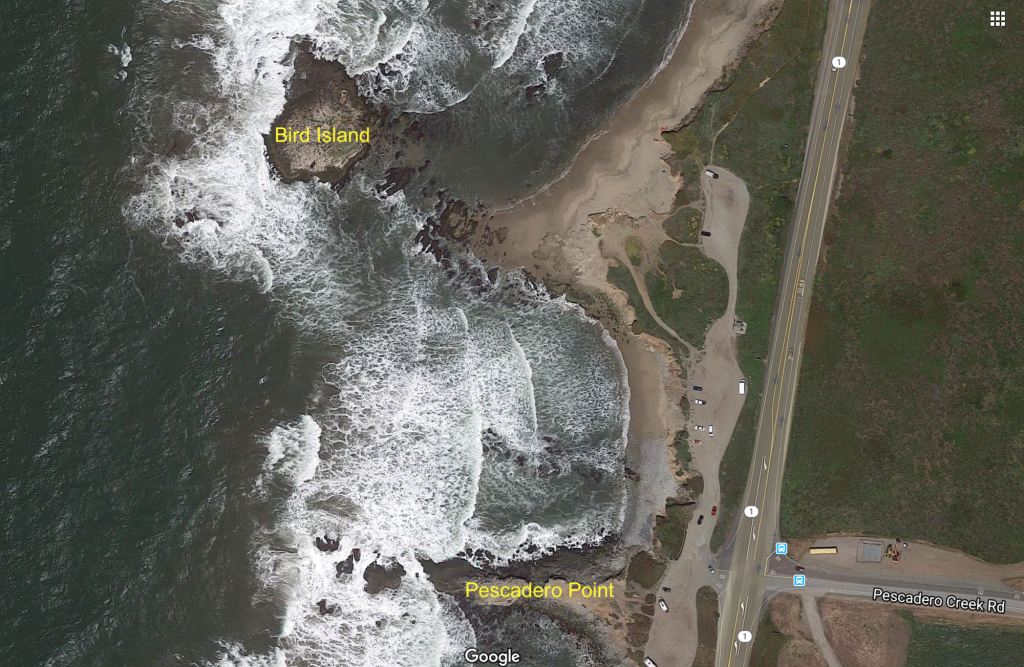
05 July 2019
The most prominent landmark along the coastline in this region is Bird Island, which is accessible only at minus tides, when it is revealed to be a peninsula. It smells pretty much as you probably imagine, especially if you happen to be downwind. Given the prevailing wind direction, that means that the closer you get to Bird Island from the south, the stronger the smell. Kathleen’s site is the south side of Pescadero Point, fortunately far enough south of Bird Island that the smell isn’t noticeable from that distance. She has a permanent transect that she surveys regularly, taking note of algal abundances and distributions.
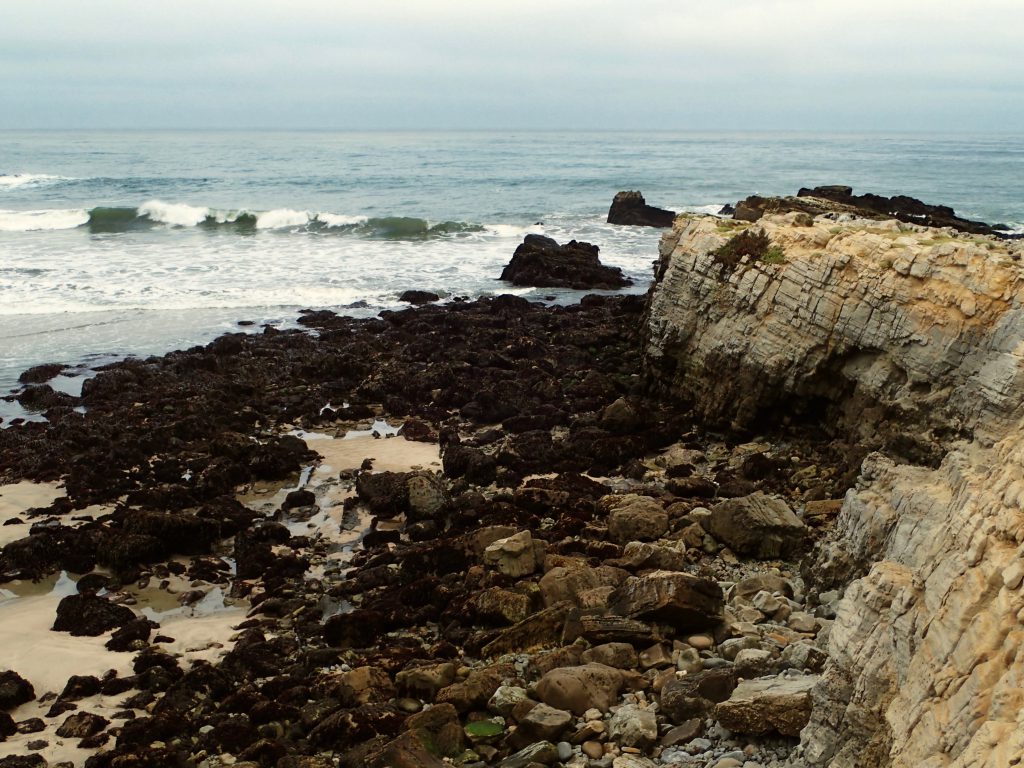
05 July 2019
© Allison J. Gong
One of the notable things we all noticed was the conspicuous presence of big, healthy ochre stars (Pisaster ochraceus)–many hand-sized or larger. I also saw many smaller stars, in the 2 cm size range, but these were hidden in crevices or under algae. The big guys and gals, were out there in plain sight.
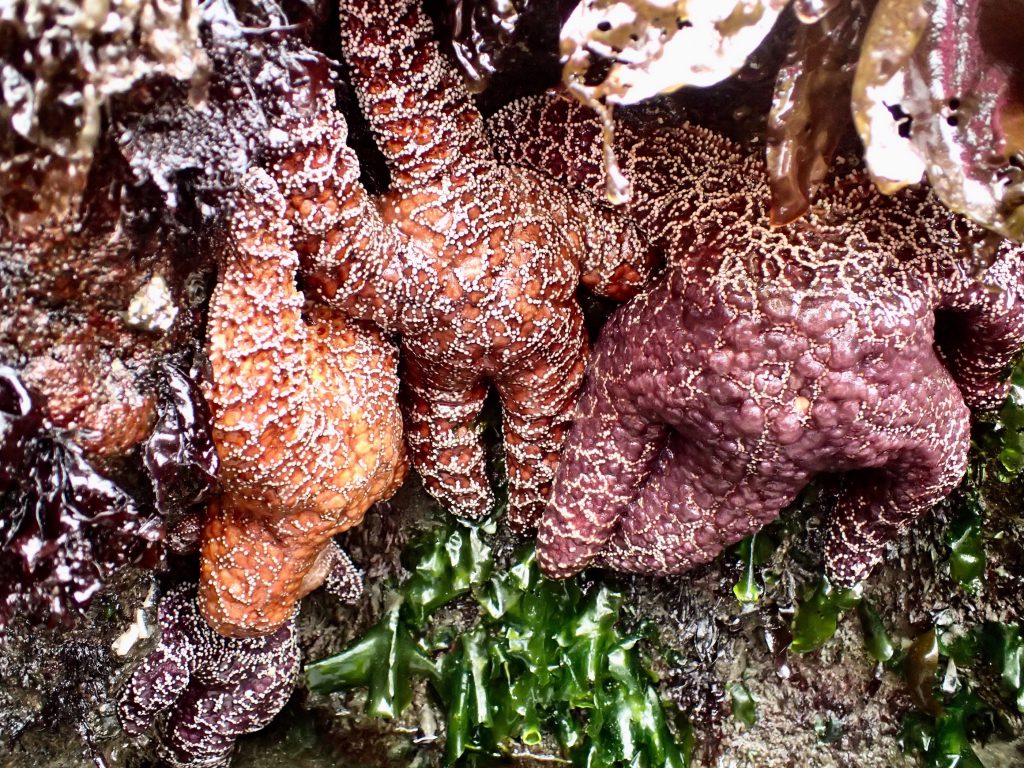
05 July 2019
© Allison J. Gong
However, not all was perfect for the sea stars at Pescadero Point. One of the ochre stars showed symptoms of sea star wasting syndrome (SSWS). It had autotomized two of its arms and had a sloppy, goopy open wound that extended into the oral disc. It was also mushy when I touched it and didn’t firm up the way healthy stars do. This star is a goner, even though it doesn’t know it yet. That’s the beauty (and in this case, tragedy) of an entirely decentralized nervous system.
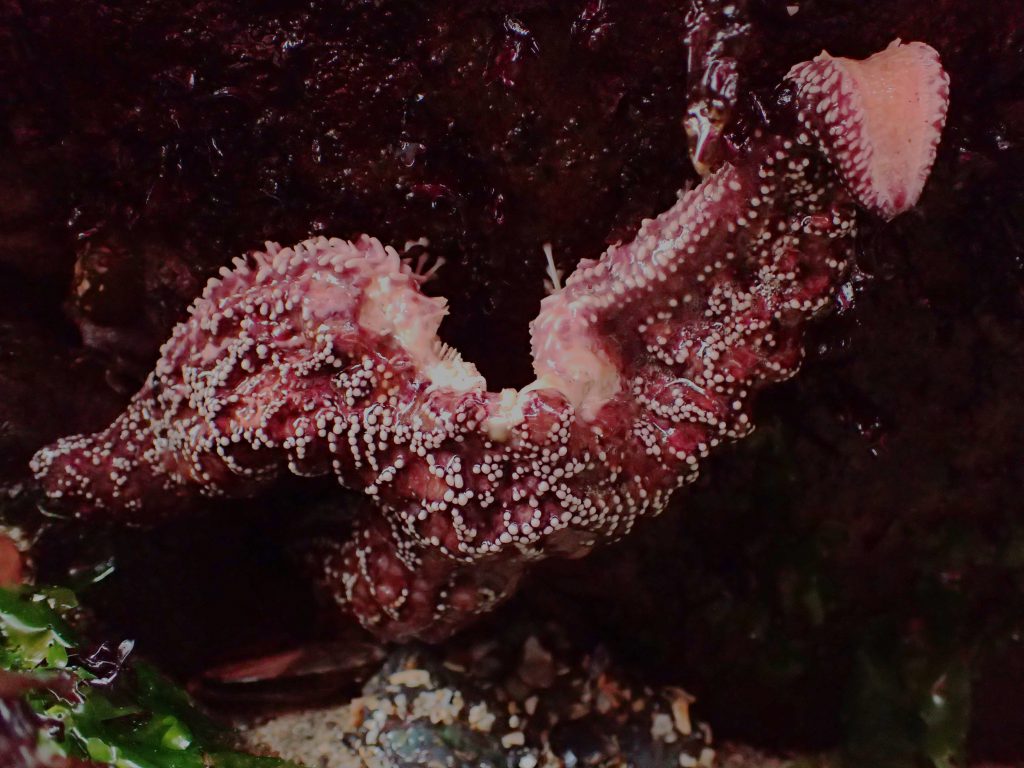
05 July 2019
© Allison J. Gong
After I mentioned having seen a sick sea star we compared notes on the current status of SSWS. What more do we know about the syndrome, and any recovery of stars? We came to the consensus that the oubreak was probably caused by a perfect storm of ecological conditions–an opportunistically pathogenic virus that is ubiquitous in the environment, environmental stresses, and high population densities both intertidally and subtidally. Kathleen asked me what I had been seeing recently. I told her that Pisaster ochraceus, one of the species that melted away in spectacular fashion, seems to be making a strong comeback in the places where I used to see it in large numbers. Even though every once in a while i see a sick star, places like Natural Bridges and Davenport Landing are again populated by lots of hand-sized-or-bigger ochre stars. Which of course brings up the question of where these large stars suddenly came from. I think they were tiny stars when the outbreak occurred, hiding in the mussel beds. Many of them died, but as with any plague there are always some survivors. Those lucky few managed to hang on and creep into the niches that opened up when so many adults died. But would little juveniles only a few millimeters in diameter be able to grow to the sizes that we’re seeing now, in ~5 years? I suppose that’s not out of the question, and we know that when fed well in the lab they grow very quickly, but individual growth rates in the field are difficult to measure.
Another animal goody that we saw were clusters of the bryozoan, Flustrellidra corniculata. Unlike most bryozoans, which are calcified and crunchy, Flustrellidra colonies are soft and flexible. They look more like strange, thick pieces of brown algae than anything recognizable as a bryozoan.
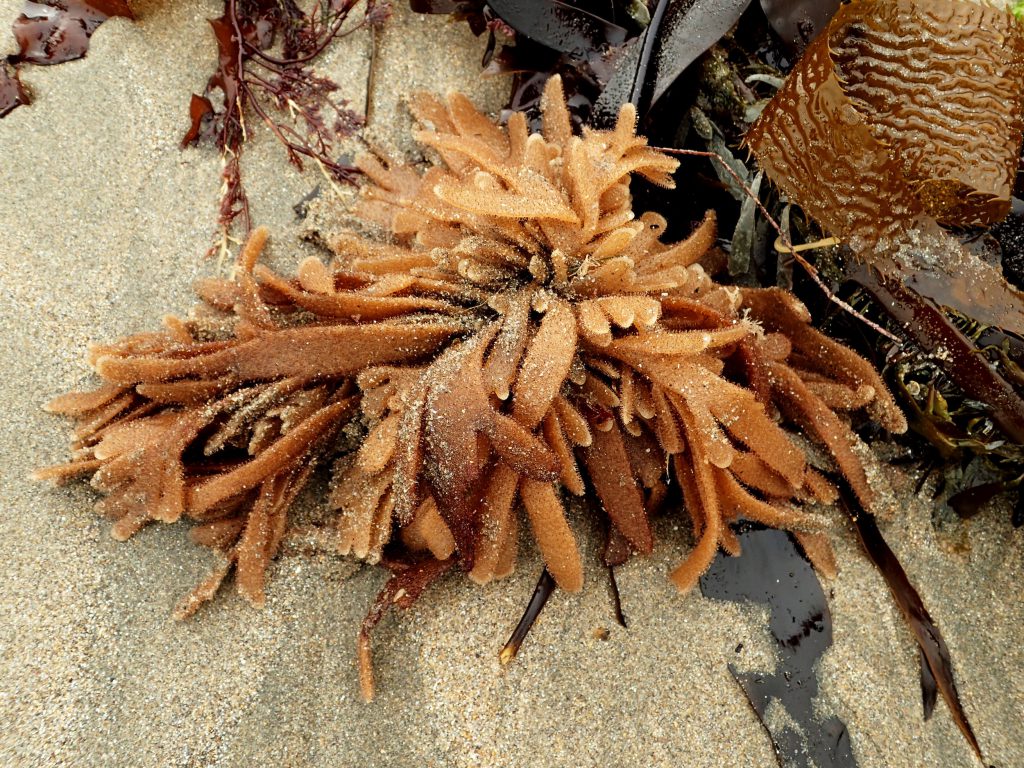
05 July 2019
© Allison J. Gong
We were there to do some basic marine botany, and although I kept getting distracted by the invertebrates I did also pay attention to the floral aspect of Kathleen’s site. She pointed out that Laminaria sinclairii, one of the small low-intertidal kelps, was always abundant. It’s true, there were rocks that were entirely covered with L. sinclairii, like this one:
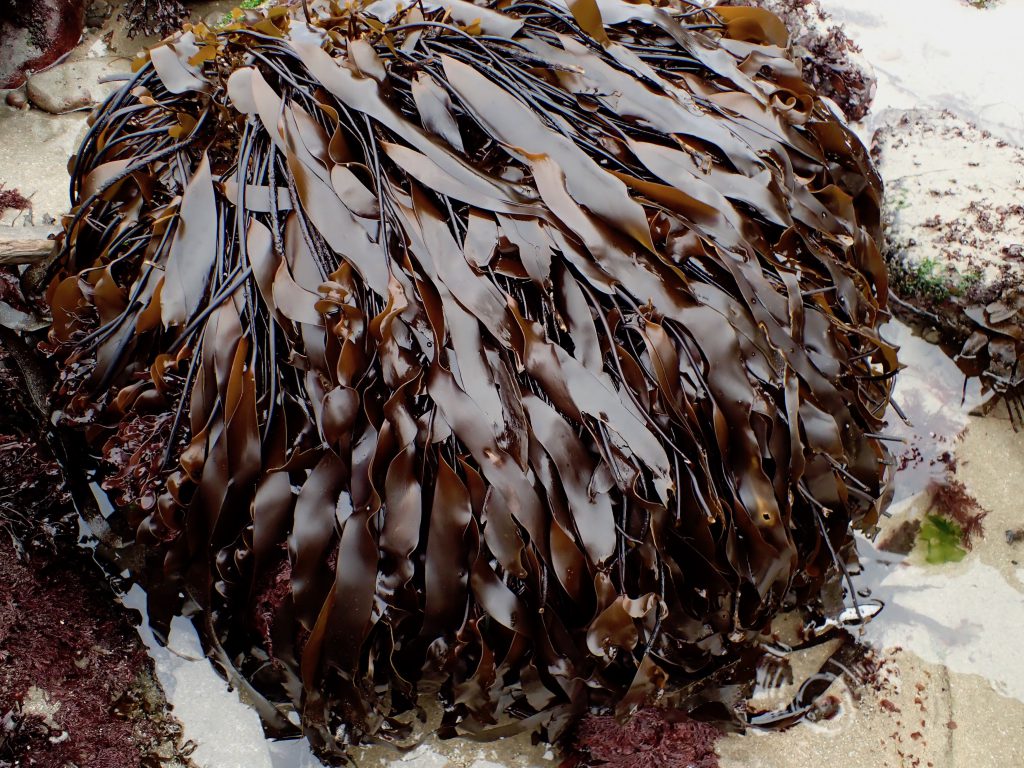
05 July 2019
© Allison J. Gong
Laminaria sinclairii and L. setchellii are the most common intertidal species of the genus on our coast. They are easily distinguishable because L. sinclairii has a single undivided blade arising from the stipe, and L. setchellii has a blade that is subdivided into fingerlike sections; in fact, the former species epithet for L. setchellii was dentigera, referring to ‘finger’.
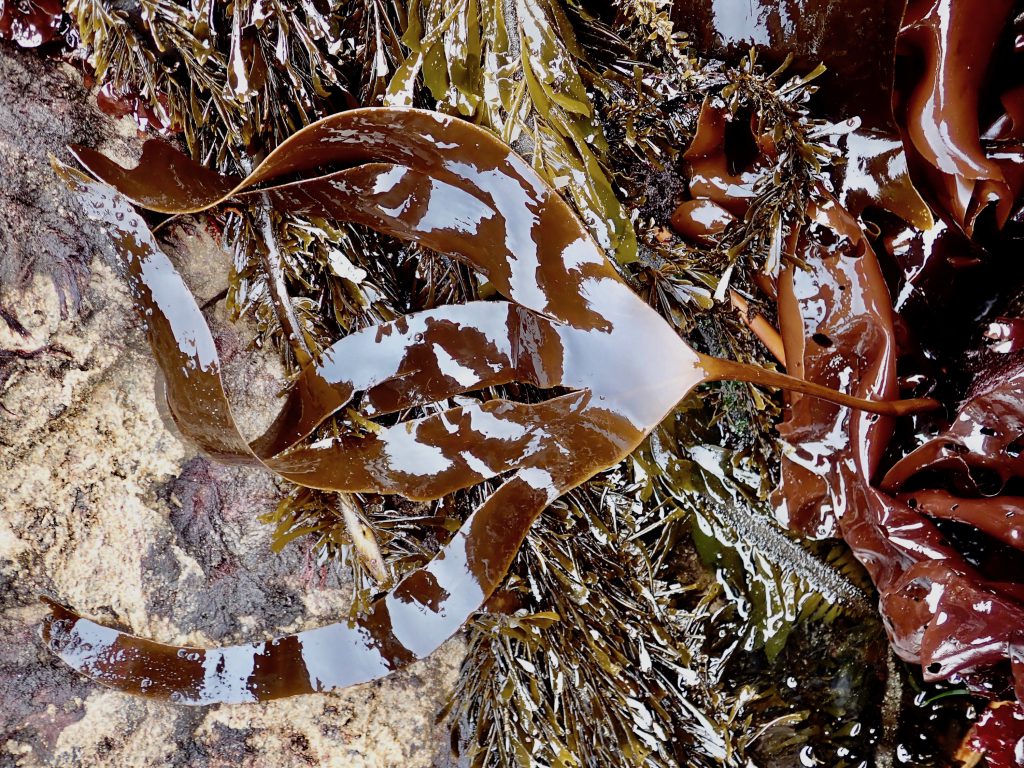
15 June 2018
© Allison J. Gong
See the difference?
There is a third species of Laminaria on our coast, that I knew only by reputation. What I’d heard is that Laminaria ephemera resembles L. sinclairii except for the morphology of the holdfast: L. ephemera has a discoid, suction-cup holdfast while L. sinclairii has the more typical hapterous holdfast (made of intertwined cylindrical projections). I think I might have seen a few L. ephemera at Pescadero. These thalli appear to have suction-cup holdfasts, don’t they?
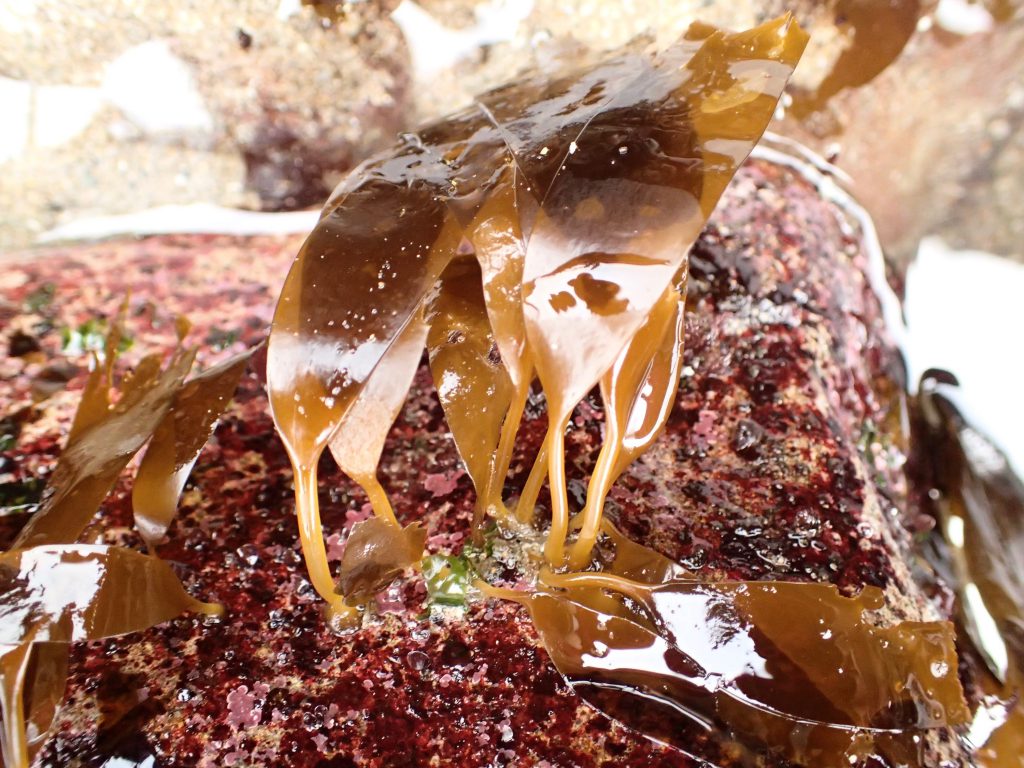
05 July 2019
© Allison J. Gong
We didn’t spend much time on the south side of the point, but scrambled over the rocks to the north side, where there are stretches of sandy beach between rocky outcrops. Bird Island is that peninsula in the top of the picture. As I mentioned above, it is connected to the beach only at low tide, so while I think of it as a peninsula, it really is an island most of the time.
Once on the north side of the point we slowed down and made some more attentive observations of the flora. It turns out that this portion of our intertidal visit was sponsored by the letter ‘P’. One of the things we all noticed was the prevalence of Pyropia, the filmy red alga that is common in the high-mid intertidal. The thallus of Pyropia consists of a single layer of cells connected to form a very thin elastic tissue. It dries to a crisp in the sun, but rehydrates when the tide returns. You’ve probably encountered Pyropia before without realizing it: nori is made of Pyropia that has been shredded and processed into paper-like sheets, used for things like sushi rolls.
Although it looks uniformly blackish-green when packaged for human consumption, Pyropia‘s color in life is a glorious iridescent mixture of greens, olives, and purples. It is another of those easily overlooked denizens of the intertidal that deserves a much closer look than it usually gets.
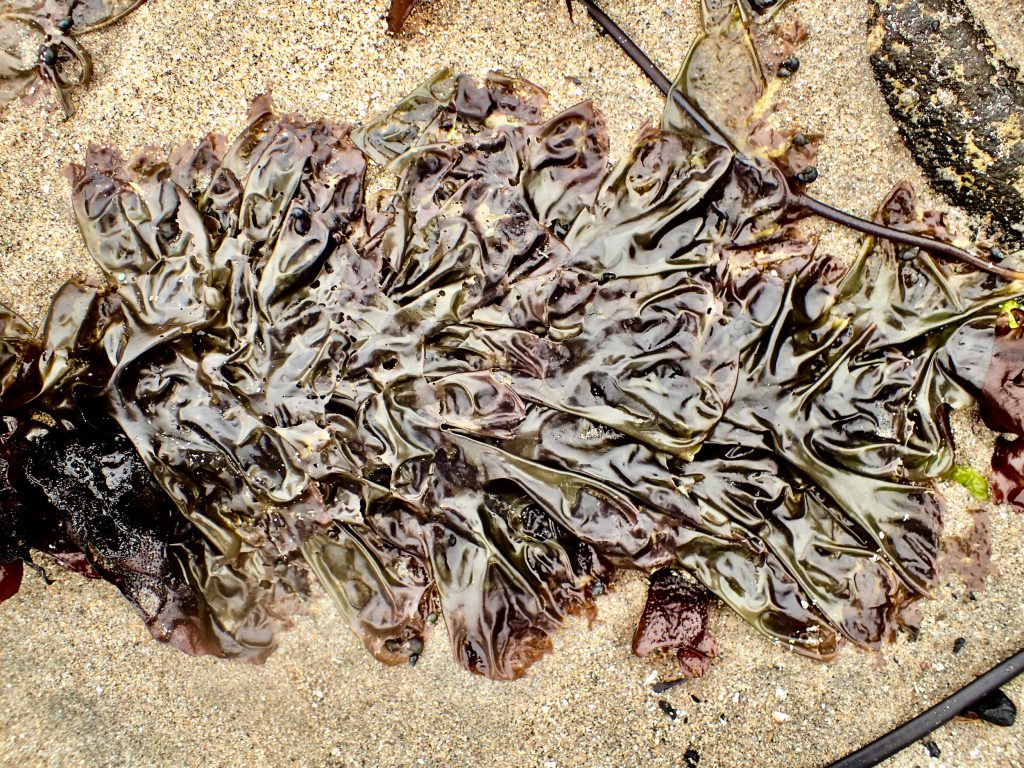
05 July 2019
© Allison J. Gong
Another common red alga at Pescadero Point is the delicate and lacy Plocamium cartilagineum. This is one of the hobbyist phycologist’s favorite species because it presses like a dream and makes great gifts or wall decorations. As I wrote about here, Plocamium has a doppelganger: Microcladia coulteri. These algae share a similar morphology, but as I mentioned in the previous post, natural history makes it easy to distinguish between the two in the field. Microcladia is epiphytic, growing on other algae, and Plocamium is not.
Plocamium grows on rock surfaces in the mid-to-low tide regions. It sometimes gets surrounded or even buried in sand, but if you dig down far enough you’ll always find the holdfast attached to a rock (or shell or other hard object).
Last month I wrote about Postelsia palmaeformis, the sea palm. We found a most handsome specimen washed up on the beach. Note that, as per usual, it wasn’t the holdfast of the kelp that failed. The holdfast did its job perfectly well, and it was the mussel it was attached to that broke free of the rock.
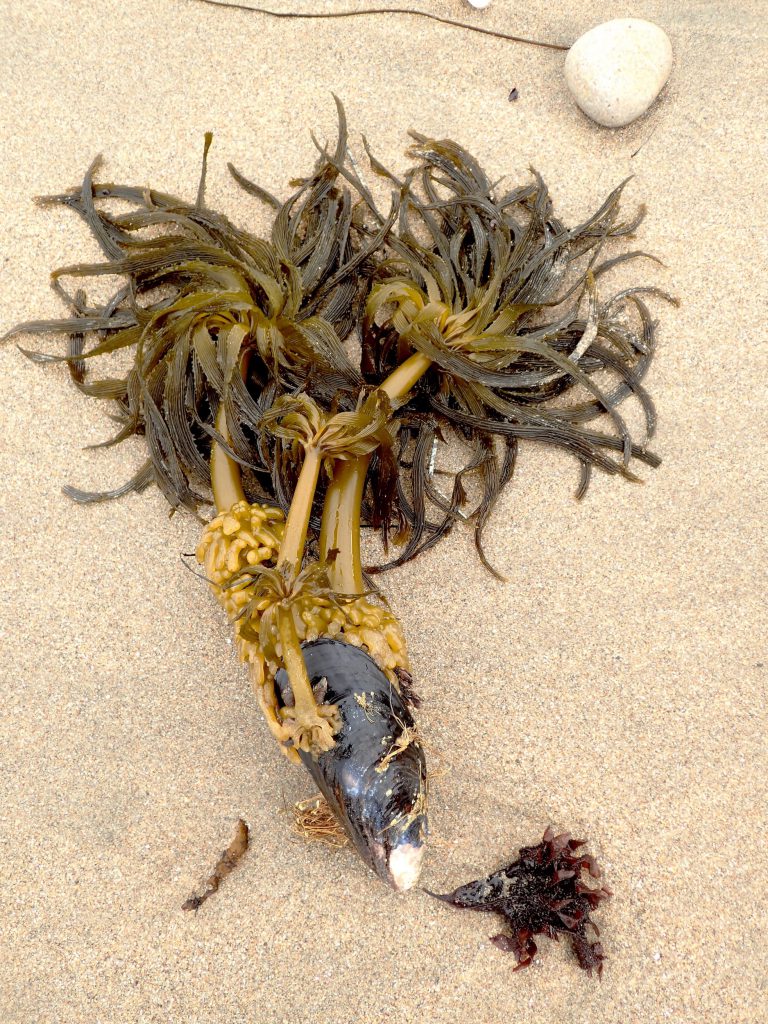
05 July 2019
© Allison J. Gong
The sad thing about finding great specimens like this on the beach is the realization that it will soon be dead. In fact, so will the mussel. Such is the price organisms pay for failing to hang onto their substrate (or for their substrate’s failure to hang on). The rocky intertidal is a harsh place to live, and can be unforgiving of mistakes and bad decisions.
That’s part of the reason I find it so fascinating. Most wild organisms live on the knife-edge of survival, with only the thinnest margin between life and death. Every organism has its predators, pathogens, and parasites to deal with on a daily basis, in addition to the physical stresses of its habitat. All of the organisms that I study in the intertidal are marine–not freshwater or even brackish, although some can tolerate reduced salinity (and on the other extreme, some tolerate very high salinity). They evolved to live in the ocean, in a habitat where the ocean abandons them for a few hours twice a day. Yet as improbable as that sounds, the diversity in the intertidal is astonishingly high. Obviously, for those that can live there, the trade-off between stability and safety is worthwhile. Nature will always find a way.

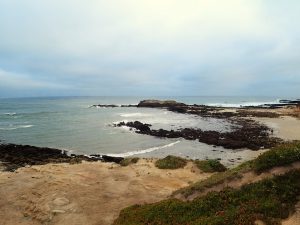
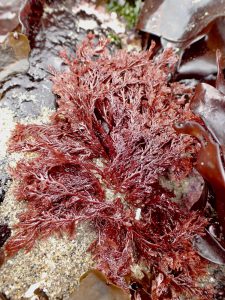
Hey Allison! Question about the Pyropia, which is SO pretty. Is it one large leaf? It looks like a wrinkled-up sheet somehow…but I suspect it’s a lot of leaves and they are just laying on top of each other, making it difficult to distinguish. Great post, I am getting more and more interested in algae each time you write and show such gorgeous photos of each specimen!! 😀